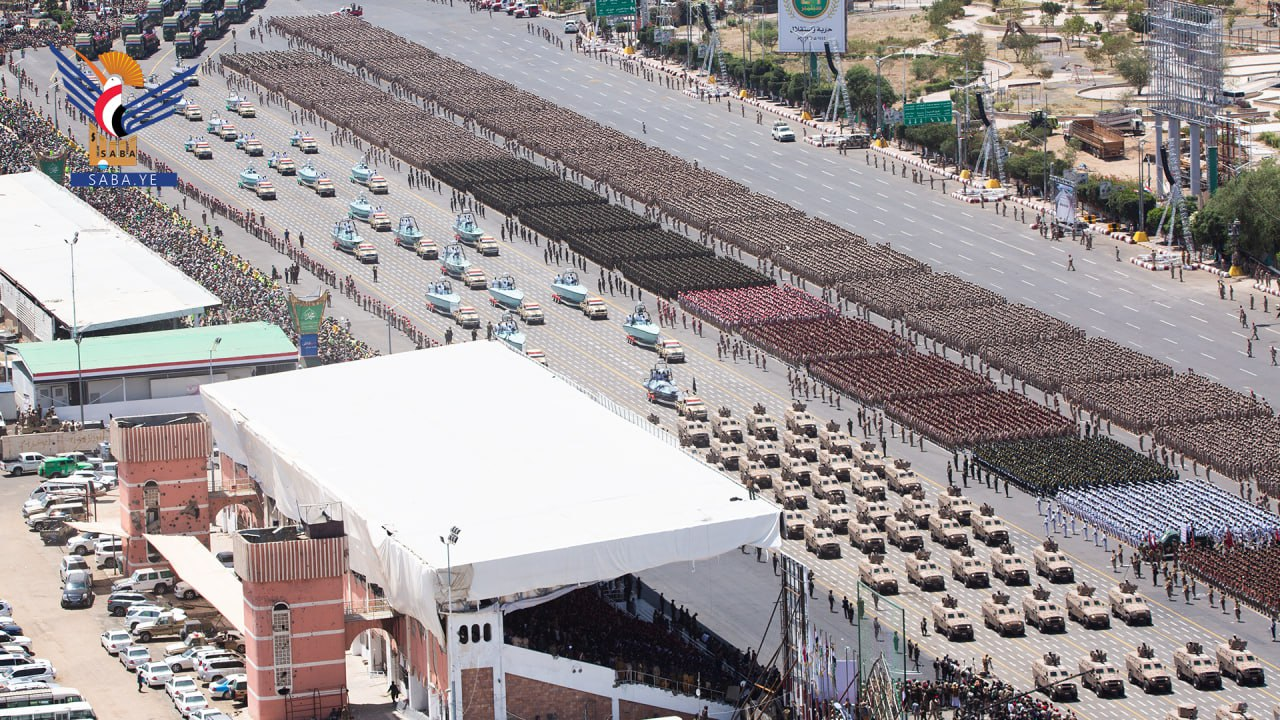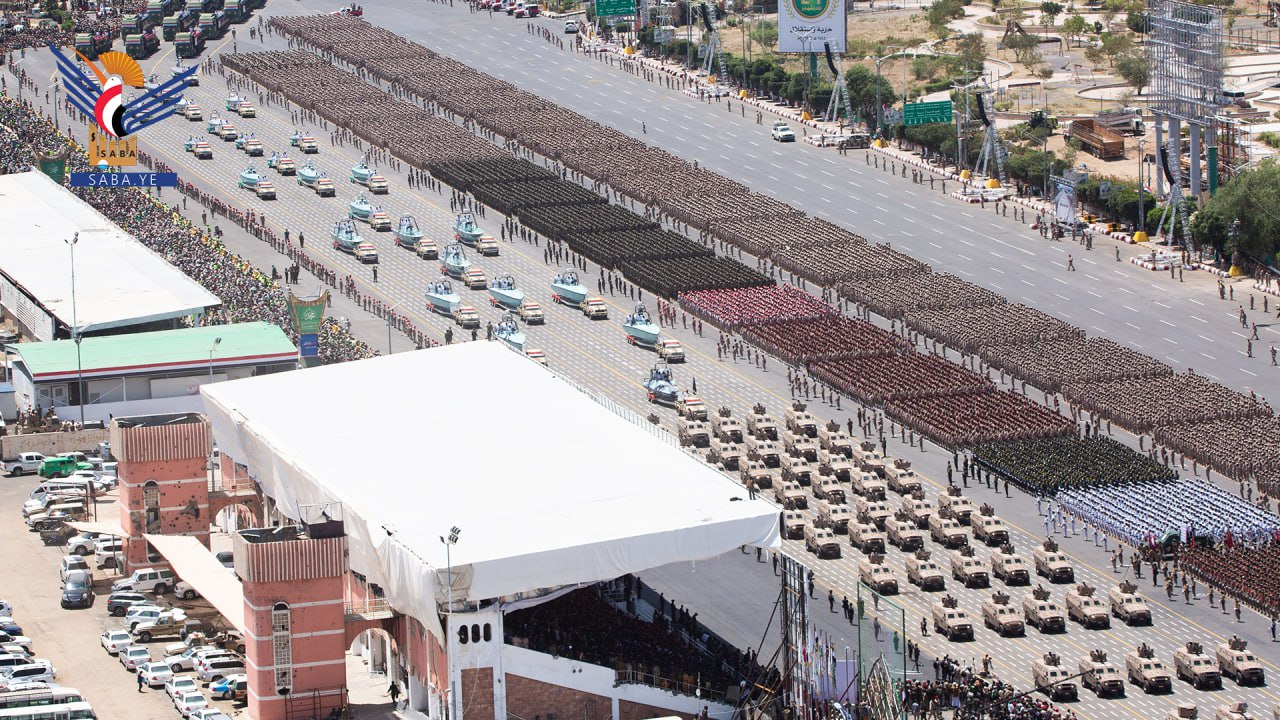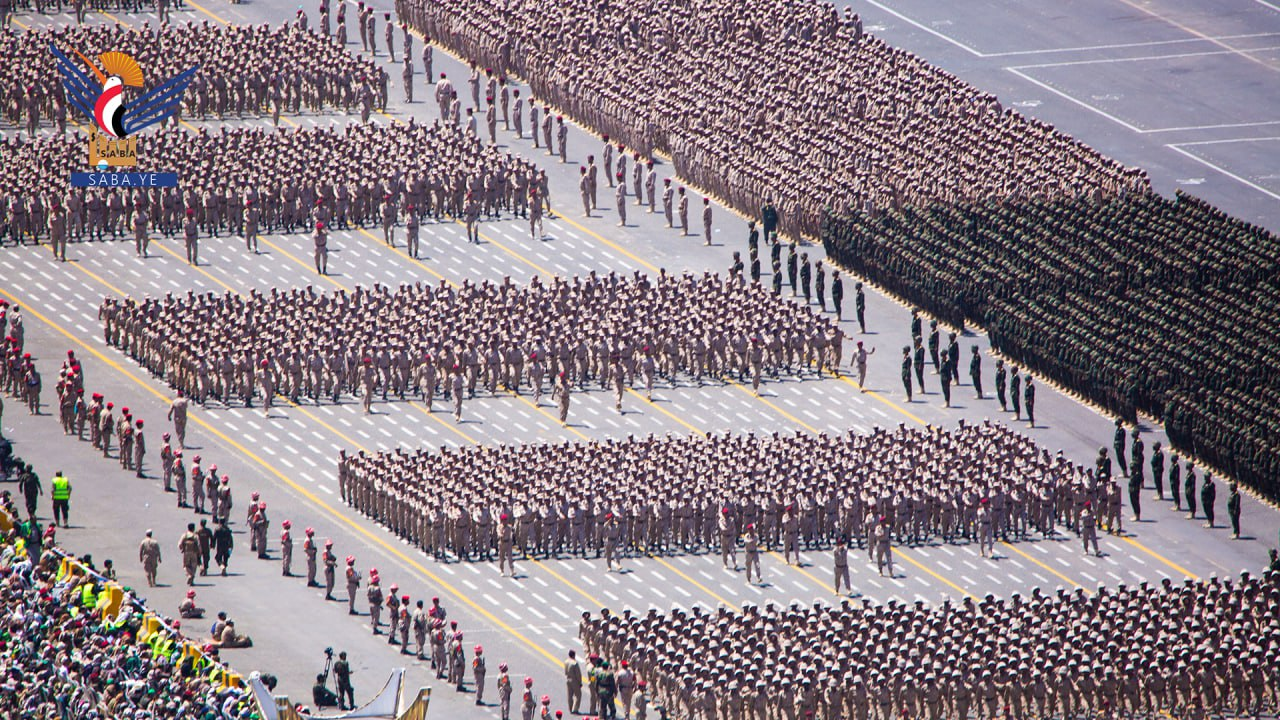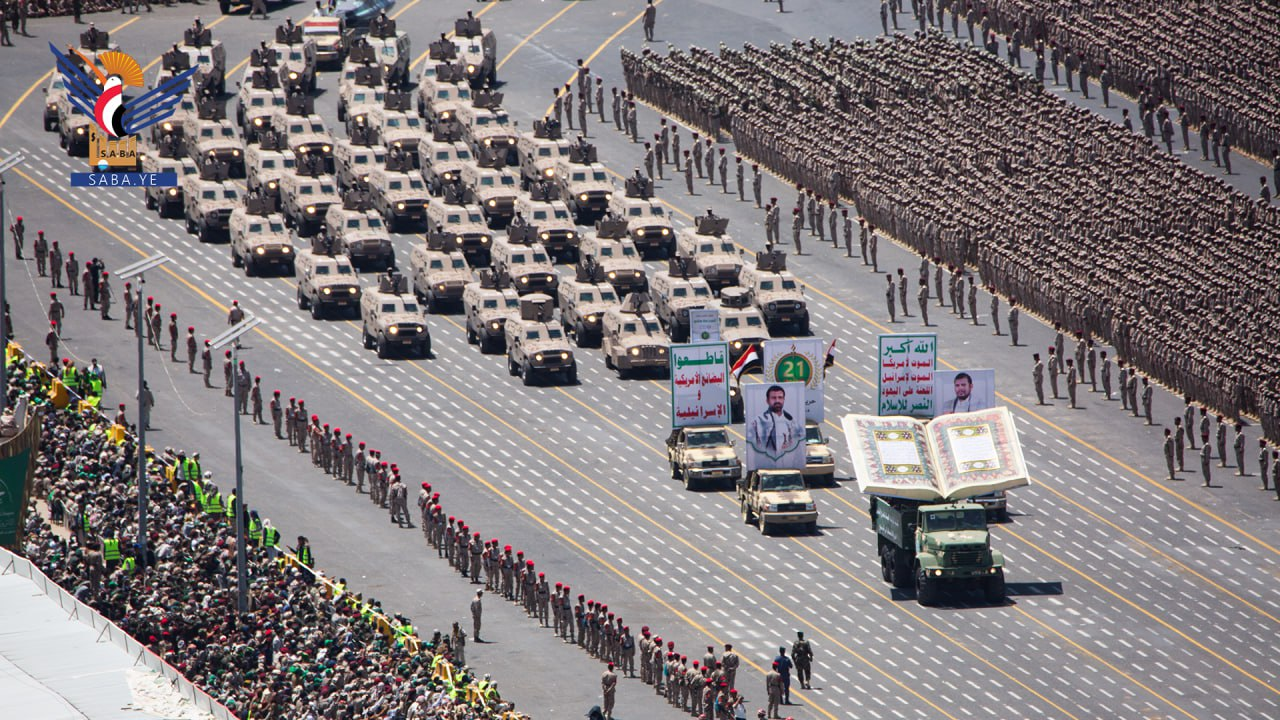
SANA'A - (Saba): The independence of political decision-making, liberating Yemen from foreign tutelage and dependence, and ridding it of the forces of corruption that have been tampering with and sharing its wealth for decades are the most important achievements of the immortal 21 September Revolution, under which Yemen witnessed many achievements and transformations at all levels.
For long periods of time, Yemen remained a mere vassal or a backyard for some regional and international powers, led by America and Saudi Arabia, which continued to buy the loyalties of successive regimes through the so-called special committee and grant salaries and budgets to sheikhs and influential people and empower them with Yemen's wealth in exchange for weakening the state and its institutions and turning it into a dependent entity and deprived of political and economic decision-making.
The Saudi-American hegemony over Yemen was manifested by its direct intervention in the state's general policies, educational curricula, official media discourse and guidance, even at the level of mosques, which sought to domesticate the Yemeni people and perpetuate the state of satisfaction and loyalty to America and other enemies of the nation, as well as interfering in and dismantling the army, infiltrating the security services and planting intelligence and terrorist elements in many government institutions.
While most countries in the region and the world witnessed an economic and cultural renaissance, Yemen remained stagnant due to the preoccupation of local proxy forces with their own interests and the implementation of foreign agendas aimed at keeping the country in the same state of chaos and political and economic dependence on foreign countries, which led to the outbreak of popular demonstrations in 2011.
In 2011, the so-called youth revolution in February of the same year failed to meet the aspirations of the Yemeni people to get rid of foreign tutelage and hegemony, advance Yemen and improve its bitter living conditions as a result of mismanagement, corruption and foreign dependence of the ruling regimes.
Saudi Arabia, as usual, was quick to intervene to protect its agents and thwart the revolution by proposing the so-called ‘Gulf Initiative’ to provide protection for the puppet leaders to ensure their survival in the political scene, and other dangerous clauses in the initiative, as well as the attempt to divide Yemen into weak entities under the name of regionalisation, so that America and its allies can continue to implement their plans and ambitions in Yemen.
The so-called ‘reconciliation government’, or rather ‘quotas’ that resulted from the Gulf initiative, lasted for about three years, during which corruption penetrated state institutions and devoured all the country's resources, rendering them incapable of performing their functions.
During those years, Yemen witnessed many economic crises that affected all areas of life and led to rising prices and a decline in the standard of living for the majority of citizens.
During that period, the US ambassador in Sana'a was the de facto ruler of the country and controlled all matters, while party leaders continued to receive directives from the US embassy to play suspicious roles that affect Yemen's sovereignty and serve US interests, which was also confirmed by the confessions of the US-Israeli spy cell recently seized by the security services.
At that time, state and party leaders turned into informants and agents of the US and Saudi ambassadors in Sana'a, who continued to control the scene and lead the country towards the abyss, so that it would be easy prey for them to fully control and share it.
At that time, the capital Sana'a and all Yemeni governorates lived through bloody weeks, during which many terrorist bombings targeted mosques, camps and public places, in addition to increasing assassinations of political figures, academics, elites, security and army officers and soldiers, up to the storming of the headquarters of the Ministry of Defence (Al-Aradi) and other crimes committed by terrorist elements during that period.
During this period, Yemen witnessed the downing of many civilian and military aircraft, the destruction of strategic weapons and defence missiles, the disabling of air defence systems, allowing US aircraft to violate Yemeni airspace and targeting many areas under the pretext of fighting terrorism, which is an integral part of the US conspiracy against Yemen.
The so-called ‘reconciliation government’, which was basically formed on the principle of sharing positions between the partners of corruption, from the highest positions to the lowest levels, pursued a policy of price increases imposed by the World Bank at high and unfair rates, which negatively affected the poor and middle-income groups, especially as it coincided with the emergence of more contrived living, economic and service crises such as targeting electricity and hiding oil derivatives in the context of a punitive policy aimed at breaking the will of the Yemeni people who rejected corruption and continued to express their aspirations through peaceful marches until 2014.
In mid-August 2014, the people revolted massively in various governorates under the leadership of Sayyid Abdulmalik Badr al-Din al-Houthi, who wisely and ably managed to lead the 21 September Revolution step by step in order to achieve its lofty goals, namely the overthrow of the trusteeship and the forces of corruption and collaboration, and the implementation of the agreed outcomes of the National Dialogue Conference before Al-Far Hadi amended them according to the wishes of America, despite the opposition of Ansar Allah, especially with regard to the division of Yemen into six provinces.
With the success of the 21 September Revolution, Yemen and its people achieved many achievements, most notably the overthrow of the project to divide the country into six rival regions, and missed the opportunity for America and its allies to exploit the events of 2011 to support corruption and looting and fuel hatred and sectarian conflicts so that they could control large parts of Yemen and plunder its wealth, as is now happening in the occupied provinces.
This young revolution took it upon itself to achieve the strategic goals that all previous revolutions had failed to achieve, the most important of which were the restoration of the stolen political decision, the absolute alignment with the people, the building of a strong national army based on correct foundations to protect the country and its resources, and the support of the causes of the Arab and Islamic nation, especially the Palestinian cause.
Indeed, the revolution succeeded in uprooting all forces of corruption, ending US influence and presence, and starting to achieve the goals and principles from which the revolution was launched, despite the great risks and challenges it faced a few months after its establishment, foremost among which was the announcement of the US-Saudi military aggression against Yemen from the moment the foreign-linked government of corruption fell, with the aim of aborting this revolution and eliminating it in its infancy.
The leadership of the revolution, represented by Commander Abdulmalik Badreddin al-Houthi, continued to translate the goals and principles of the 21 September Revolution into realistic strategies and action plans, and adopted many important goals in order to establish a new phase of construction, development and advancement of the country according to strategic plans that keep pace with the requirements of development and achieve the aspirations of the Yemeni people to establish a strong, free and independent state.
The 21 September Revolution was distinguished by its peaceful and tolerant approach, even with those who stood against it, and focused on preserving state institutions, which earned it great public support as it was the first real Arab revolution launched by a national will in order to correct the course of the September and October revolutions and the subsequent events that were turned into a card to reshape the country with the same corrupt arms and according to its vision and suspicious agendas.
In order to establish a political partnership with all national forces on the scene, the Peace and Partnership Document following the 21 September Revolution stipulated the formation of a government of competencies and national partnership, the fight against corruption, and the recovery of the country's resources from the hands of looters and plunderers.
Despite the signing of the Peace and Partnership Document by all political forces and parties, and the international and international support for the document, greedy and domineering countries in Yemen considered this revolution, which brought free national forces to power, an imminent threat to their interests, and fabricated unrealistic pretexts, after which they declared military aggression against Yemen in March 2015.
Regardless of the aggression, the blockade and the economic war that the US and its allies have waged and continue to wage on Yemen, the process of transformation laid out within the objectives of the 21 September Revolution has continued at all levels, while confronting the aggression, strengthening the factors of steadfastness and developing Yemen's military capabilities, leading to the possession of strategic deterrence weapons that enabled Yemen to respond to the aggression countries by targeting their depth and strategic installations, doubling their economic losses, forcing them to review their accounts and realise the size of the predicament they have reached as a result of their unjustified aggression against Yemen.
In line with the remarkable development in military production and manufacturing and the building of the armed forces on correct foundations based on loyalty to God and the homeland and carrying the jihadist spirit, many visions, strategies and national executive programmes were launched to revive and recover the economy, including encouraging local production in the agricultural and industrial sectors and seeking to achieve self-sufficiency as a realistic translation of the directives of the revolutionary leadership aimed at moving Yemen to a new reality that meets the aspirations and hopes of all the Yemeni people.
The plans focused on achieving a set of important and necessary national objectives and entitlements for the stage, on top of which is strengthening economic and social resilience and cohesion as a necessity to face the serious effects and repercussions of the aggression and blockade, especially after the aggression deliberately destroyed Yemen's resources and infrastructure, causing extremely serious economic and humanitarian crises.
All this has contributed to achieving economic stability and correcting many of the structural imbalances that prevailed in government work for decades and made Yemen a consumer country dependent on imports to cover all its needs.
Consequently... Since 2014, Yemen has witnessed many legislative reforms related to the performance of institutions to enable them to keep pace with developments in their field of work, by reviewing all laws and proposing the necessary amendments to carry out the tasks required of them in serving citizens and sustainable development in the country.
Under the supervision and continuous follow-up of the Leader of the Revolution and the head of the Supreme Political Council, state institutions have engaged in many battles to meet the needs of citizens, including reforming the judicial system, local authorities, combating corruption, and other administrative and economic reforms related to the performance of institutions, which have been met with great satisfaction by citizens.
At the same time, the state and the government adopted effective financial and economic policies that directly contributed to maintaining the currency exchange rate in the governorates administered by the Supreme Political Council, while the rial continued to collapse in the occupied southern governorates, causing a deterioration in the economic situation and widening the circle of living and humanitarian suffering for citizens in those governorates.
Based on the objectives of the 21 September Revolution, economic and financial policies have achieved many economic reforms, despite the lack of basic revenue sources, namely oil and gas revenues, ports and outlets, fisheries wealth and others, which remained until today in the hands of the aggression and its mercenaries.
Thanks to the 21st September Revolution, Yemen has reached the great dignity and prestige it enjoys today, especially after its heroic and honourable stand alongside the brotherly Palestinian people and their valiant resistance in the Al-Aqsa flood battle, during which Yemen revealed new, more advanced and longer-range weapons that enabled it to target the depth of the Zionist enemy in the occupied Palestinian territories.
For long periods of time, Yemen remained a mere vassal or a backyard for some regional and international powers, led by America and Saudi Arabia, which continued to buy the loyalties of successive regimes through the so-called special committee and grant salaries and budgets to sheikhs and influential people and empower them with Yemen's wealth in exchange for weakening the state and its institutions and turning it into a dependent entity and deprived of political and economic decision-making.
The Saudi-American hegemony over Yemen was manifested by its direct intervention in the state's general policies, educational curricula, official media discourse and guidance, even at the level of mosques, which sought to domesticate the Yemeni people and perpetuate the state of satisfaction and loyalty to America and other enemies of the nation, as well as interfering in and dismantling the army, infiltrating the security services and planting intelligence and terrorist elements in many government institutions.
While most countries in the region and the world witnessed an economic and cultural renaissance, Yemen remained stagnant due to the preoccupation of local proxy forces with their own interests and the implementation of foreign agendas aimed at keeping the country in the same state of chaos and political and economic dependence on foreign countries, which led to the outbreak of popular demonstrations in 2011.
In 2011, the so-called youth revolution in February of the same year failed to meet the aspirations of the Yemeni people to get rid of foreign tutelage and hegemony, advance Yemen and improve its bitter living conditions as a result of mismanagement, corruption and foreign dependence of the ruling regimes.
Saudi Arabia, as usual, was quick to intervene to protect its agents and thwart the revolution by proposing the so-called ‘Gulf Initiative’ to provide protection for the puppet leaders to ensure their survival in the political scene, and other dangerous clauses in the initiative, as well as the attempt to divide Yemen into weak entities under the name of regionalisation, so that America and its allies can continue to implement their plans and ambitions in Yemen.
The so-called ‘reconciliation government’, or rather ‘quotas’ that resulted from the Gulf initiative, lasted for about three years, during which corruption penetrated state institutions and devoured all the country's resources, rendering them incapable of performing their functions.
During those years, Yemen witnessed many economic crises that affected all areas of life and led to rising prices and a decline in the standard of living for the majority of citizens.
During that period, the US ambassador in Sana'a was the de facto ruler of the country and controlled all matters, while party leaders continued to receive directives from the US embassy to play suspicious roles that affect Yemen's sovereignty and serve US interests, which was also confirmed by the confessions of the US-Israeli spy cell recently seized by the security services.
At that time, state and party leaders turned into informants and agents of the US and Saudi ambassadors in Sana'a, who continued to control the scene and lead the country towards the abyss, so that it would be easy prey for them to fully control and share it.
At that time, the capital Sana'a and all Yemeni governorates lived through bloody weeks, during which many terrorist bombings targeted mosques, camps and public places, in addition to increasing assassinations of political figures, academics, elites, security and army officers and soldiers, up to the storming of the headquarters of the Ministry of Defence (Al-Aradi) and other crimes committed by terrorist elements during that period.
During this period, Yemen witnessed the downing of many civilian and military aircraft, the destruction of strategic weapons and defence missiles, the disabling of air defence systems, allowing US aircraft to violate Yemeni airspace and targeting many areas under the pretext of fighting terrorism, which is an integral part of the US conspiracy against Yemen.
The so-called ‘reconciliation government’, which was basically formed on the principle of sharing positions between the partners of corruption, from the highest positions to the lowest levels, pursued a policy of price increases imposed by the World Bank at high and unfair rates, which negatively affected the poor and middle-income groups, especially as it coincided with the emergence of more contrived living, economic and service crises such as targeting electricity and hiding oil derivatives in the context of a punitive policy aimed at breaking the will of the Yemeni people who rejected corruption and continued to express their aspirations through peaceful marches until 2014.
In mid-August 2014, the people revolted massively in various governorates under the leadership of Sayyid Abdulmalik Badr al-Din al-Houthi, who wisely and ably managed to lead the 21 September Revolution step by step in order to achieve its lofty goals, namely the overthrow of the trusteeship and the forces of corruption and collaboration, and the implementation of the agreed outcomes of the National Dialogue Conference before Al-Far Hadi amended them according to the wishes of America, despite the opposition of Ansar Allah, especially with regard to the division of Yemen into six provinces.
With the success of the 21 September Revolution, Yemen and its people achieved many achievements, most notably the overthrow of the project to divide the country into six rival regions, and missed the opportunity for America and its allies to exploit the events of 2011 to support corruption and looting and fuel hatred and sectarian conflicts so that they could control large parts of Yemen and plunder its wealth, as is now happening in the occupied provinces.
This young revolution took it upon itself to achieve the strategic goals that all previous revolutions had failed to achieve, the most important of which were the restoration of the stolen political decision, the absolute alignment with the people, the building of a strong national army based on correct foundations to protect the country and its resources, and the support of the causes of the Arab and Islamic nation, especially the Palestinian cause.
Indeed, the revolution succeeded in uprooting all forces of corruption, ending US influence and presence, and starting to achieve the goals and principles from which the revolution was launched, despite the great risks and challenges it faced a few months after its establishment, foremost among which was the announcement of the US-Saudi military aggression against Yemen from the moment the foreign-linked government of corruption fell, with the aim of aborting this revolution and eliminating it in its infancy.
The leadership of the revolution, represented by Commander Abdulmalik Badreddin al-Houthi, continued to translate the goals and principles of the 21 September Revolution into realistic strategies and action plans, and adopted many important goals in order to establish a new phase of construction, development and advancement of the country according to strategic plans that keep pace with the requirements of development and achieve the aspirations of the Yemeni people to establish a strong, free and independent state.
The 21 September Revolution was distinguished by its peaceful and tolerant approach, even with those who stood against it, and focused on preserving state institutions, which earned it great public support as it was the first real Arab revolution launched by a national will in order to correct the course of the September and October revolutions and the subsequent events that were turned into a card to reshape the country with the same corrupt arms and according to its vision and suspicious agendas.
In order to establish a political partnership with all national forces on the scene, the Peace and Partnership Document following the 21 September Revolution stipulated the formation of a government of competencies and national partnership, the fight against corruption, and the recovery of the country's resources from the hands of looters and plunderers.
Despite the signing of the Peace and Partnership Document by all political forces and parties, and the international and international support for the document, greedy and domineering countries in Yemen considered this revolution, which brought free national forces to power, an imminent threat to their interests, and fabricated unrealistic pretexts, after which they declared military aggression against Yemen in March 2015.
Regardless of the aggression, the blockade and the economic war that the US and its allies have waged and continue to wage on Yemen, the process of transformation laid out within the objectives of the 21 September Revolution has continued at all levels, while confronting the aggression, strengthening the factors of steadfastness and developing Yemen's military capabilities, leading to the possession of strategic deterrence weapons that enabled Yemen to respond to the aggression countries by targeting their depth and strategic installations, doubling their economic losses, forcing them to review their accounts and realise the size of the predicament they have reached as a result of their unjustified aggression against Yemen.
In line with the remarkable development in military production and manufacturing and the building of the armed forces on correct foundations based on loyalty to God and the homeland and carrying the jihadist spirit, many visions, strategies and national executive programmes were launched to revive and recover the economy, including encouraging local production in the agricultural and industrial sectors and seeking to achieve self-sufficiency as a realistic translation of the directives of the revolutionary leadership aimed at moving Yemen to a new reality that meets the aspirations and hopes of all the Yemeni people.
The plans focused on achieving a set of important and necessary national objectives and entitlements for the stage, on top of which is strengthening economic and social resilience and cohesion as a necessity to face the serious effects and repercussions of the aggression and blockade, especially after the aggression deliberately destroyed Yemen's resources and infrastructure, causing extremely serious economic and humanitarian crises.
All this has contributed to achieving economic stability and correcting many of the structural imbalances that prevailed in government work for decades and made Yemen a consumer country dependent on imports to cover all its needs.
Consequently... Since 2014, Yemen has witnessed many legislative reforms related to the performance of institutions to enable them to keep pace with developments in their field of work, by reviewing all laws and proposing the necessary amendments to carry out the tasks required of them in serving citizens and sustainable development in the country.
Under the supervision and continuous follow-up of the Leader of the Revolution and the head of the Supreme Political Council, state institutions have engaged in many battles to meet the needs of citizens, including reforming the judicial system, local authorities, combating corruption, and other administrative and economic reforms related to the performance of institutions, which have been met with great satisfaction by citizens.
At the same time, the state and the government adopted effective financial and economic policies that directly contributed to maintaining the currency exchange rate in the governorates administered by the Supreme Political Council, while the rial continued to collapse in the occupied southern governorates, causing a deterioration in the economic situation and widening the circle of living and humanitarian suffering for citizens in those governorates.
Based on the objectives of the 21 September Revolution, economic and financial policies have achieved many economic reforms, despite the lack of basic revenue sources, namely oil and gas revenues, ports and outlets, fisheries wealth and others, which remained until today in the hands of the aggression and its mercenaries.
Thanks to the 21st September Revolution, Yemen has reached the great dignity and prestige it enjoys today, especially after its heroic and honourable stand alongside the brotherly Palestinian people and their valiant resistance in the Al-Aqsa flood battle, during which Yemen revealed new, more advanced and longer-range weapons that enabled it to target the depth of the Zionist enemy in the occupied Palestinian territories.








